

 |
 |
The Indianapolis Athletic Club was
organized in 1920 at a meeting held in the Chamber of Commerce Building.
The IAC purchased the Fahnley Home at the southwest corner of Meridian
and Vermont, began construction in 1921 and moved into the nine story
club facility in 1924. |
|
| |
 |
It is significant that in December,
1920, the newly elected IAC Board of Directors determined as the club's
first athletic promotion to host the AAU National Championships at the
Broad Ripple Park pool the summer of 1921 --- three years before the IAC
building would be completed. The 1921 AAU Senior National Championships
were indeed held at the remarkable
Broad Ripple Park Pool, the largest outdoor pool in the world at the
time it was built in 1908.
The 1924 Olympic Trials were also held at the Broad Ripple Park Pool.
|
|
| |
 |
In 1926 Richard Papenguth became the
IAC's Swimming Instructor/Aquatic Director. Coach Papenguth had just
graduated from the University of Michigan where he had been a star
swimmer and diver. Coach Papenguth promoted aquatics for men and women,
boys and girls of the IAC including swimming, diving and water
basketball, and popular water partie |
|
| |
|
| |
The Polar Bears for men and Dolphins for women were organized. The fabled
and unique water game of "biddy ball" (similar to water volley ball) was
created, and "Swimming the English Channel" became an annual lap swim
motivation for members of the Polar Bears.
|
| |

The IAC developed strong men and women's competitive squads.
|
|

Jack Merriam, son of William, was an outstanding IAC tanker winning the
100 freestyle in a dual meet against Stanford with a time of 58.1. |
|
| |

Frank Kennedy, a great star for the
IAC in the late 1920's, won many events in the Midwest as well as in the
National Interscholastic (high school) Championships at Northwestern.
Frank went on to swim for University of Michigan. |
|

Two IAC outstanding divers - Al Benham and Frank Fehsenfelt - competed
in the 1936 Olympic Trials. Both competed for the University of Michigan
and became NCAA Champions.
|
|
| |

Between 1928-1938, IAC produced twelve
Junior National Champions. June Fogle and Virginia Hunt are pictured
holding plaques which hung in the pool area and listed the names of
these champions. Interestingly, June won the 800 mtr. freestyle in the
1992 Master's Championships swimming, a time that was faster than
when she won the Junior Nationals in 1938 - 54 years later! |
|

Al Rust was an outstanding IAC swimmer in the 1930's,
a member of the Junior National Champion Water Polo Team, named to the
High School All-American Interscholastic Swimming Team, and won the high
point trophy at the City Meet many times. |
|
| |
 |
Dick Paperguth was a
great innovator producing a number of training aids years ahead of his
time. Several of these would become commercialized 30 to 40 years later.
Bob Woolling and Betty Clemons are shown demonstrating "tethered
swimming." |
|

"Mirrors" helped swimmers to actually see their
strokes and technique. Virginia Hunt is shown with Pappy's poolside
mirror. |
|
| |
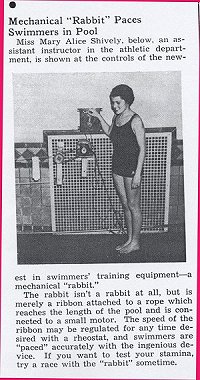
Mary Alice Shively is shown with a
remarkable mechanical "Rabbit" which predated the underwater "Pacer
Lights" which became popular in the 1970's. |
|

Coach Papenguth promoted fun and enjoyment at
poolside. Pictured here are Joan Fogle, Mary Aspinall, Patty Aspinall
and June Fogle roasting hot dogs at a mid-January marshmallow roast and
swimming party. |
|
| |

Patty Aspinall, the Fogles, and others
trained with Coach Papenguth at the IAC in the winter. In the summers,
Pappy worked in the Matt Mann Summer Camps in Canada. so the girls
trained on their own at the Riviera Club, built in 1933 by Jim Makin. |
|
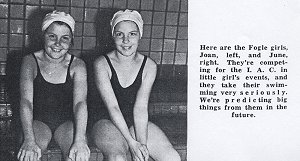
In 1937 INDAC featured a picture with Joan and June Fogle and predicted
"big things from them in the future." Both sisters would become AAU
Senior National Champions. |
|
| |
 |
The Shakamak State
Park meet was an annual summer highlight for decades. June Fogle and
Patty Aspinall are shown with some of their awards earned at an early
Shakamak meet. |
|

Patty Aspinall as a 12 year old ws the first swimmer
to use the overarm butterfly recovery for the entire 220 breastroke in a
national swim race and broke a six year old American record that year.
Patty also qualified for the 1940 Olympics (on the same team with future
movie star Esther Williams), but the Olympics were cancelled due to
World War II. |
|
| |
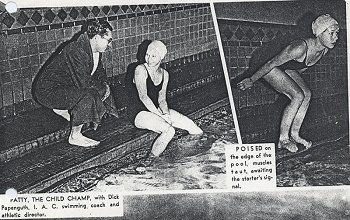
Coach Papenguth is shown with his
young star Patty Aspinall. |
|
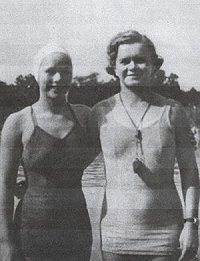
Patty Aspinall was taught to swim at the Riviera Club
by Olympic Gold medalist Euphrasia Donnelley. Here Patty, five time
national champion & Olympic Team member, is shown with her
instructor/mentor. |
|
| |
When Coach Paperguth moved up to West Lafayette to coach the Big Ten Purdue
University Swim Team, the IAC Board of Directors decided to de-emphasize the
competitive athletic program and reserve the pool for use by club members.
Patty Aspinall, June and Joan Fogle
then moved over to the Riviera club which had just built it's indoor pool
and hired Bud Sawin to coach the team. Bud had been a star high school
swimmer in Columbus and coached Butler University and the Hoosier Athletic
club. He spent a short time coaching the lakeside Club in Louisville in the
summer where he had produced a national championship team.
|
| |
 |
The former IAC stars were the nucleus
of an incredible Riviera Women's team which won the AAU Senior National
Championships Team Title in 1941, 1942, 1943 and 1944. Jim Makin and
Coach Bud Sawin are shown with the national team. |
|
| |
 |
The 1943 AAU National Championships
was held at Shakamak State Park. Betty Bemis, who had become a WAVE, was
permitted to compete for the Riviera Club in this championship.
|
|
| |
 |
Swimmers in the 1940's were glamorous
- Patty, June, Joan and others of the Riviera Squad appeared in national
publications. |
|
| |
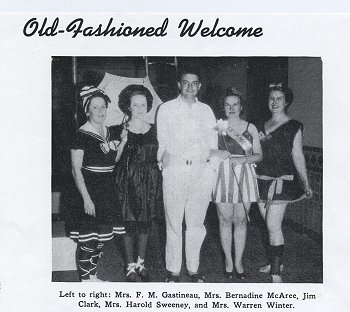 |
In the meantime, IAC had hired young
Jimmy Clark in 1940, but he entered the Navy just a few months later. At
the end of the war in 1945, Jim received an 'old fashioned' welcome from
the Dolphins when he returned to the Club. |
|
| |
 |
Coach Clark, like Papenguth, developed
a comprehensive aquatic program for men and women, boys and girls of all
ages. This included swimming, diving, lifesaving, water ball sports and
water-ballet. Shown here are two of the top IAC synchronized swimmers -
Sara Ann and Mary Margaret Carroll performing
at the Muncie Country Club. The picture below are others who worked
diligently performing routines. Some will recognize Judy Roberts, Ginger
Allbright, Sue Ziegler, Carol Kirchner, Sue Kirby and the Blackledge
twins. |
|
| |
 |
Coach Clark developed Junior and
Senior men's and women's competitive programs. Tommy Lord is pictured
after winning the 12-under high point trophy in the 1948 city meet, and
the IAC men's state championships 400 freestyle relay included Fran
McAree, Dan Nyhart, Doug Simmons and Everett Brooks. |
|
| |
 |
By the early 1950's, the IAC program
was one of the largest in the country. The IAC team trained at the Broad
Ripple Park Pool in the mornings and many outdoor meets were held at the
Ripple Pool as well. Some of us spent six hours a day i the summer
training: 7-9 a.m. at Broad Ripple, 2-4 p.m. at the IAC and back to the
club after dinner for a 7-9 p.m. practice. |
|
| |

IAC swimmers won local, state and
Midwest team titles on a regular basis, and Coach Clark often got wet |
|

Coach Clark is climbing out after a victorious plunge
- note the cigar was not lost! |
|
| |
|
| |
|
| |
|
| |
|

